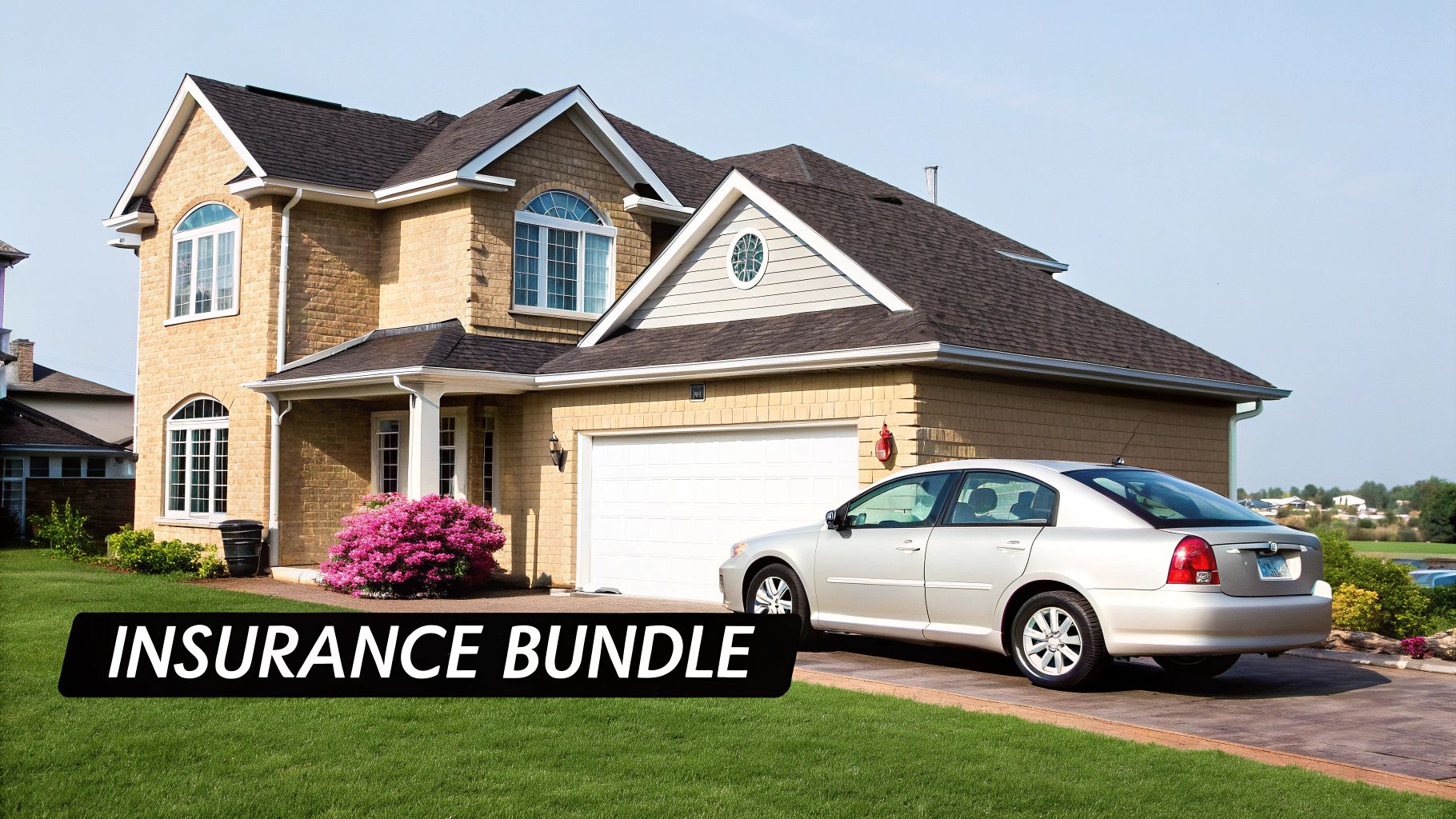Why Savvy Homeowners Bundle Their Insurance Policies

Managing numerous insurance policies from various companies can be a complex and expensive undertaking. Many homeowners are opting to bundle their home and auto insurance with a single provider for greater simplicity and potential cost savings. This trend reflects a growing demand for efficient and valuable insurance coverage.
Streamlined Management: Simplicity At Your Fingertips
Bundling insurance offers unparalleled convenience. Instead of juggling multiple companies, agents, and payment due dates, everything is managed through a single provider. This translates to one point of contact for all customer service needs, one online platform to manage policies, and just one premium payment. Updating personal information or making payments becomes significantly easier, saving valuable time and reducing the chances of missed payments or lapses in coverage.
Having a single insurer also simplifies the claims process, especially when an incident affects both home and car, like a fallen tree damaging both.
Substantial Savings: The Financial Perks Of Bundling
Besides streamlined management, bundling often yields significant financial benefits. Many insurers offer multi-policy discounts, which can range from 5% to 25% or more on each policy. Over time, these savings can be substantial, making bundling a financially attractive option.
Bundling is a popular practice, particularly in North America. In Canada, approximately 55% of homeowners choose to bundle, while a similar 56% do so in the United States. This preference is driven by the desire for simplified management and cost reduction. More detailed statistics are available from Deloitte.
It's always wise to compare bundled quotes with separate policies to ensure the best possible value. In some cases, individual policies from different insurers might offer better rates, depending on individual circumstances and available discounts. For further insights on navigating the insurance market, check out this helpful article: Navigating the Home Insurance Market: Tips for Finding the Best Policy in 2025.
Beyond The Basics: Additional Bundling Advantages
Bundling offers more than just cost savings and easier management. Some insurers provide combined deductibles for events affecting both home and car, minimizing out-of-pocket expenses when filing a claim. This can be particularly beneficial during events like severe weather, which can damage both property and vehicles.
Bundling can also strengthen your relationship with your insurance provider. This often leads to improved customer service and more personalized attention, which can be invaluable when navigating complex claims or seeking expert advice on coverage options. Bundling offers a compelling combination of convenience, affordability, and enhanced service, making it a smart choice for homeowners seeking optimal insurance protection.
The Real Savings Behind Bundling Discounts

Bundling your home and auto insurance offers more than just convenience; it can lead to substantial savings. While insurers advertise significant percentage discounts, the actual amount you save can vary. Understanding how these discounts are calculated is crucial for maximizing your benefits.
Decoding the Discount Structure
Insurance companies usually calculate bundle discounts as a percentage off each policy's premium. For example, you might receive a 15% discount on auto insurance and a 10% discount on homeowners insurance. If your annual auto premium is $1,000 and your home premium is $500, you'd save $150 on auto and $50 on home insurance, for a total of $200 in annual savings.
However, these percentages aren't set in stone. Factors such as your location, driving record, and property characteristics can all impact the final discount. Homeowners in areas prone to natural disasters may see smaller discounts on the home insurance portion of their bundle. Similarly, drivers with a history of accidents could receive a smaller discount on their auto insurance.
Untangling the Variables Affecting Discounts
The variation in discount percentages stems from how insurance providers assess risk. Bundling provides a more complete view of your risk profile. A clean driving record and a well-maintained home suggest lower risk, potentially leading to a higher discount. On the other hand, multiple claims on either policy could lower your discount.
While advertised discounts offer a general idea, your individual circumstances significantly impact the final savings. Bundling often leads to significant discounts, typically ranging from 10% to 25% on each policy. These percentages can vary by state and coverage level.
Rising Auto Premiums and Customer Satisfaction
Increases in auto insurance premiums are influencing bundling trends. A 2022 J.D. Power study revealed that rising auto costs are causing dissatisfaction among bundled policyholders, with nearly one-third considering switching their home insurer if their auto premiums continue to rise. Learn more about this trend here. This highlights the importance of balancing savings with customer satisfaction.
Evaluating Your Bundle’s True Value
To determine a bundle’s real value, compare the bundled price with the combined cost of separate policies. Consider not only the initial discount but also potential future premium increases and the overall quality of coverage. Check out our guide on ranking the best car insurance providers of 2025.
By thoroughly analyzing your options and comparing prices, you can decide if bundling truly meets your needs. Don't just focus on advertised discounts; delve deeper to understand the specific savings based on your individual profile.
To further illustrate potential savings, let's look at typical discount ranges offered by different providers.
Average Bundle Discount Ranges by Insurance Provider
This table compares the typical discount percentages offered by major insurance companies when bundling home and auto policies.
| Insurance Provider | Auto Discount Range | Home Discount Range | Average Total Savings |
|---|---|---|---|
| Provider A | 10% – 15% | 5% – 10% | 15% – 25% |
| Provider B | 15% – 20% | 10% – 15% | 25% – 35% |
| Provider C | 5% – 10% | 5% – 10% | 10% – 20% |
As you can see, the combined savings from bundling can vary considerably between insurance providers. It's important to compare quotes from multiple companies to find the best deal for your specific needs. Remember that these are just average ranges, and your actual discounts may differ. Always obtain personalized quotes to accurately assess your potential savings.
How Market Forces Are Reshaping Insurance Bundling

Bundling home and auto insurance has long been a standard practice for saving money and simplifying insurance management. However, evolving trends within the insurance market are influencing both the value and design of these bundled policies. Understanding these market forces is crucial for consumers.
The Impact of Economic and Climate Trends
Several factors are currently reshaping the insurance bundling landscape. Inflation, for instance, is increasing the costs of repairs and replacements, leading to higher premiums across the board. The rising frequency and severity of extreme weather events further contribute to the financial pressure on insurers.
This pressure causes insurance carriers to re-evaluate their pricing models, particularly for home insurance in high-risk areas. Regional market dynamics also play a significant role. In areas with high insurer density, competition often results in more attractive bundling discounts. Conversely, regions with fewer insurers may offer less compelling bundle options.
These broader market trends significantly impact the stability of home and auto insurance bundles. In 2024, for example, new home insurance policies saw an average premium increase of 17.4% due to factors like inflation and severe weather. This underscores the potential for future premium hikes, putting further strain on bundled policies.
Insurers are adapting by emphasizing bundling as a way to manage risk and maintain profitability. However, consumers are increasingly comparing bundled policies with separate policies, seeking better rates or specialized coverage. This is especially true considering the variability in local market conditions and climate-related risks. Learn more about future insurance trends here.
Adapting to Shifting Discount Structures and Coverage
As insurers respond to market pressures, their bundling strategies are evolving. Some providers are modifying their discount percentages, while others are introducing tiered bundling options with varying levels of coverage and discounts. The traditional, universal discount may become less prevalent, potentially replaced by more personalized offers based on individual risk assessments. Bundling can free up budget to explore other options, like increased coverage or potential savings on term life insurance rates.
Navigating the Evolving Bundle Market
For consumers, staying informed about these changes is essential for making sound insurance decisions. Comparing bundle offers from multiple providers and thoroughly evaluating coverage options and discount structures is crucial.
Don't solely focus on the advertised discount. Instead, compare the total cost of the bundled policy against separate policies, considering your individual long-term insurance needs. By staying proactive and informed, you can navigate these market changes effectively and secure the best possible home and auto coverage at a competitive price.
When Keeping Policies Separate Makes More Sense

Bundling home and auto insurance is often presented as the most budget-friendly route. However, it isn't always the ideal solution for every individual. Sometimes, maintaining separate policies offers superior coverage or even lower overall expenses. Understanding these scenarios helps you make informed decisions tailored to your specific needs.
Specialized Needs and Coverage
Separate policies might be the better option when you need specialized coverage. For example, owners of historic homes often require policies covering the unique risks associated with older properties. A mainstream bundle provider may not offer this specialized coverage, or it could be significantly more expensive. Choosing a specialized home insurance provider and a separate auto insurance policy might offer better protection and value.
This also applies to drivers categorized as high-risk. Some insurers specialize in covering high-risk drivers, often offering more competitive rates than standard bundled options. Similarly, if you own a classic car, a standard bundled auto insurance policy might not adequately cover its value. A specialized classic car insurance policy becomes necessary for proper protection.
Cost Comparison: Bundle vs. Separate
Another crucial consideration is the potential for lower total costs with separate policies. While bundle discounts can be substantial, comparing the bundled price with the combined cost of separate policies from different insurers is essential. Sometimes, the total cost of two individually discounted policies from different companies is less than a bundled rate.
This can be especially true when factoring in the variety of discounts available from individual providers. One company might offer a substantial discount for homeowners with specific safety features, while another might offer lower auto insurance rates for drivers with clean records. Strategically choosing individual policies based on these discounts can lead to lower overall premiums compared to a bundled option.
The Value of Shopping Around
Bundling can sometimes discourage consumers from comparing rates. The convenience of a single provider often makes comparing quotes from multiple companies seem like too much effort. However, regularly comparing insurance rates is vital to ensure you're getting the best possible value.
Maintaining separate policies simplifies this process, allowing you to shop for each policy independently without being tied to a bundled package. This flexibility helps you capitalize on changing market conditions and secure the most competitive rates for both home and auto insurance. Carefully evaluating your individual needs and comparing quotes from different providers empowers you to determine whether bundling or separate policies truly suits you best. Consulting with an independent insurance agent can also help navigate the options and secure the necessary coverage at the best possible price.
Maximizing Your Bundle Benefits: Insider Tactics
Bundling home and auto insurance offers a convenient way to manage payments and often comes with a discount. However, to truly maximize your savings, a more strategic approach is needed. Simply accepting the first offer isn’t enough. Savvy consumers can use several tactics to unlock greater value and ensure their bundled policy truly meets their needs.
Comparing Bundle Offerings Across Providers
Not all bundles are the same. Discounts can vary significantly between insurance companies. What works best for one person might not be the best deal for another. Pro Tip: Get quotes from several insurers. Don't just compare the advertised discount percentages; look at the total premium cost after the discount. This direct comparison will clearly show which provider offers the most competitive bundled rate.
Identifying Hidden Savings Opportunities
Many insurers offer additional savings beyond the standard bundle discount. These can include discounts for safety features in your home, such as smoke detectors or burglar alarms, or for maintaining a clean driving record. Some insurers even offer discounts for bundling other types of insurance, like life or umbrella policies. Explore all available discounts with each provider to uncover potential hidden savings. This proactive approach can significantly lower your overall insurance costs.
Negotiating Better Rates and Coverage
Don't hesitate to negotiate with insurance providers. If you've found a better offer elsewhere, use it as leverage. See if your current insurer will match or even beat it. Bundling makes you a valuable customer. Insurers are often willing to negotiate on both price and coverage to keep your business. This can lead to significant savings and a policy that’s better suited to your needs. Learn more in our article about how to master choosing the right home insurance policy.
Strategic Adjustments to Coverage Limits and Deductibles
Optimizing your bundle also involves carefully considering your coverage limits and deductibles. Increasing your deductible can lower your premium, but make sure you can afford the higher out-of-pocket expense if you need to make a claim. You might also need to increase certain coverage limits to adequately protect your assets. Key Takeaway: Balancing premiums, deductibles, and coverage limits is crucial for maximizing value without sacrificing necessary protection.
Timing Considerations and Transitioning Between Providers
Timing matters when searching for the best bundle deal. Insurance companies regularly adjust their pricing and discount structures. Shopping around during these periods can uncover particularly good offers. When switching providers, ensure continuous coverage between your old and new policies. This seamless transition avoids unexpected expenses. Many insurers offer prorated refunds for unused premiums, ensuring you don’t lose money when switching mid-term.
To help you optimize your bundle, review the checklist below. It highlights key actions and their benefits, as well as an estimated difficulty level for implementation.
Bundle Optimization Checklist: A comprehensive checklist of actions to take before and during the bundling process to ensure maximum savings and appropriate coverage.
| Action Item | Potential Benefit | Implementation Difficulty (1-5) |
|---|---|---|
| Compare quotes from multiple insurers | Find the lowest overall premium | 2 |
| Inquire about all available discounts (safety features, multi-policy, etc.) | Reduce premium costs beyond the standard bundle discount | 2 |
| Negotiate with insurers using competitor offers as leverage | Secure better rates and coverage | 3 |
| Adjust deductibles and coverage limits to find an optimal balance | Lower premiums while ensuring sufficient protection | 4 |
| Time your insurance shopping strategically | Take advantage of pricing adjustments and promotional periods | 3 |
| Ensure seamless coverage transition when switching providers | Avoid gaps in protection and unexpected costs | 2 |
By using this checklist, you can ensure that you're getting the most out of your bundled insurance.
By implementing these tactics, you can turn your insurance bundle from a simple discount into a powerful tool for optimizing your insurance costs and improving your overall financial well-being.
The Evolution of Bundling: Where Smart Coverage Is Heading
The insurance industry is constantly changing, and bundling home and auto insurance is no different. Driven by new technologies and evolving consumer expectations, the future of bundled insurance offers greater personalization, flexibility, and simplified management.
AI-Powered Personalization: Tailoring Coverage to Your Needs
Artificial intelligence (AI) is becoming increasingly important in how insurers assess risk. This allows them to offer more personalized bundle pricing based on individual risk profiles. Instead of standard discounts, future bundles might offer dynamic pricing that adjusts to your specific situation. This includes factors like your driving habits, home security features, and even credit history. This means safer drivers and homeowners with strong security measures could see substantially larger discounts.
Mobile-First Management: Insurance at Your Fingertips
Mobile technology is changing how consumers interact with their insurance companies. Imagine managing both your home and auto policies through a single, user-friendly mobile app. This makes filing claims, paying bills, updating policy information, and even contacting customer support much faster and more efficient. This shift toward mobile-first management simplifies the entire insurance experience, making bundled policies even more convenient.
Emerging Players and Innovative Bundling Models
New insurtech companies are disrupting traditional bundling models. Some startups are offering subscription-based insurance, where you pay a monthly fee for a combined home and auto coverage package. Others are exploring usage-based insurance models integrated with smart home technology. This technology monitors behaviors like driving patterns and home energy use to further personalize pricing and risk assessment. These new models are pushing the boundaries of what bundling can be, giving consumers more innovative and flexible choices.
Evolving Consumer Expectations: Demand for Transparency and Customization
Consumers are increasingly demanding transparency and customization in their insurance coverage. They want to know exactly what their policy covers, how their premiums are calculated, and what options are available for adjusting their coverage. This demand for greater transparency is encouraging insurers to simplify their policies, clearly explain coverage and pricing, and offer more adaptable bundle options.
These trends suggest a future where bundling home and auto insurance isn't just about saving money. It's about having a personalized, seamless, and convenient insurance experience. By staying aware of these developments, consumers can take full advantage of the innovative bundling solutions to come.
Comments are closed.